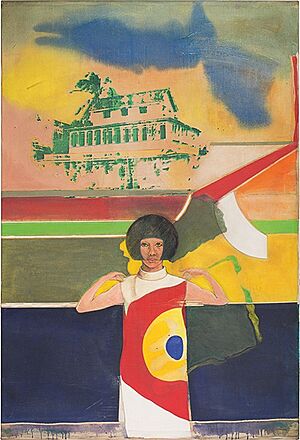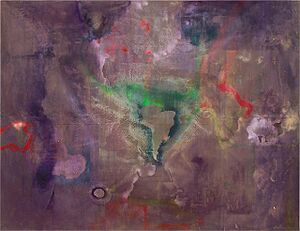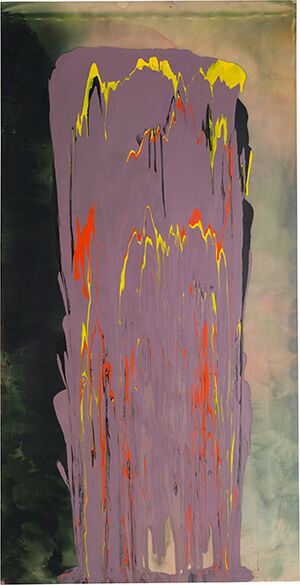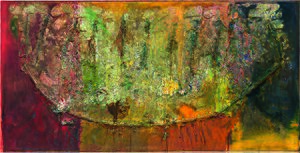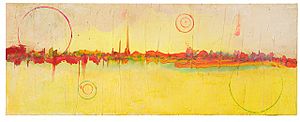Frank Bowling facts for kids
Quick facts for kids
Frank Bowling
|
|
|---|---|
| Born |
Richard Sheridan Franklin Bowling
26 February 1934 Bartica, British Guiana, South America
|
| Nationality | British |
| Alma mater | Chelsea School of Art; Royal College of Art |
| Known for | Large-scale, abstract "map paintings", and his use of found objects |
| Movement | Abstract expressionism, Color Field painting and Lyrical Abstraction |
| Spouse(s) | Paddy Kitchen 1960–1966 Irena Delderfield (m. 1969) Rachel Scott 2013–present |
Sir Frank Bowling is a famous British artist. He was born in British Guiana (now Guyana) on February 26, 1934. He is known for his large, abstract paintings. These artworks often feature bright colors and unique textures.
Many people call him "one of Britain’s greatest living abstract painters." He is also seen as a very important Black artist from the time after World War II. Frank Bowling was the first Black artist to become a member of the Royal Academy of Arts. His art has been shown in many major museums around the world. These include the Museum of Modern Art in New York and Tate Britain in London.
Frank Bowling studied art at several schools. These included the Chelsea School of Art and the Royal College of Art. At the Royal College, he studied alongside other famous artists like David Hockney.
Contents
Early Life and Art School
Frank Bowling was born in Bartica, British Guiana, in 1934. His father was an accountant for the police. His mother was a very talented seamstress and dressmaker. She built a successful business called "Bowling's Variety Store."
In 1953, when he was 19, Frank Bowling moved to Britain. He first studied English. After serving in the Royal Air Force, he met another artist, Keith Critchlow. Keith inspired Frank to study art, even though Frank had wanted to be a poet and writer.
Frank Bowling then went to the Chelsea School of Art. In 1959, he won a scholarship to the Royal College of Art in London. There, he joined a group of talented students. These included David Hockney and R. B. Kitaj.
When he first started at the Royal College, Frank Bowling painted still-life pictures. He also drew figures. Some of his early paintings, like the "Sheep’s Head" series, used muted colors. Another series from 1960, called "The Athletes," used bright, lively colors. Frank Bowling finished his studies at the Royal College of Art in 1962.
Frank Bowling's Art Career
Early Paintings and Pop Art (1950s and 1960s)
Frank Bowling's art career began with his first public show in London in 1962. In 1963, he started teaching painting at the Camberwell School of Art. He began to use images of his mother's store in his paintings.
One important early painting is Cover Girl (1966). It features a young woman from a magazine cover. Another masterpiece from this time is Mirror (1964–66). In this painting, Frank Bowling appears twice, showing a sense of change and new beginnings.
"Map Paintings" (1967–1971)
From 1967 to 1971, Frank Bowling created his famous "map paintings." He used map shapes to organize his flat, modern artworks. These large paintings were shown in his first solo museum exhibition. This show was at the Whitney Museum of American Art in 1971.
"Poured Paintings" (1974–1978)
In 1974, Bowling started making "poured paintings." He built a special platform that could tilt. This allowed him to pour paint onto the canvas. The paint would flow down, creating unique lines and patterns. These paintings often had a tall, rectangular shape. They showed a mix of planned technique and chance. A show of these paintings was held at Tate Britain in 2012.
1980s Art
By the early 1980s, Frank Bowling's paintings became very thick and textured. He often used a lot of gel in his work. In 1984, he started adding different objects to his paintings. These included newspaper, plastic, and foam.
In 1986, he had a big exhibition at the Serpentine Gallery in London. Important works like Wintergreens (1986) and Spreadout Ron Kitaj (1986) were shown. In 1987, he created Philoctete’s Bow. This painting has a complex, textured surface with pieces glued and stitched onto it.
Towards the end of the 1980s, Bowling created his "Great Thames" series. These paintings honored famous English landscape painters like J. M. W. Turner. He also began making sculptures during this time.
2000s to Today
In 2009, Bowling made a series of "zipper" paintings. These included Epps (2009). They featured vertical and horizontal lines, suggesting skies or horizons. In 2011, he showed new works called "Crossings." These paintings had thick bands of color built up in the center of the canvas.
In recent years, Frank Bowling's work has been shown in many major exhibitions. A large show of his art was at Tate Britain in 2019. Another important exhibition, Frank Bowling's Americas, was at the Museum of Fine Arts Boston in 2022-2023. His paintings are in collections all over the world. In 2024, the Tate Library in Brixton hosted an exhibition of his work.
Art Criticism and Teaching
From 1969 to 1972, Frank Bowling wrote for Arts Magazine. He believed that Black artists should be free to create abstract art. He argued against the idea that they should only make political art. His writings helped shape important discussions about "black art."
In 1969, he organized an important exhibition called 5+1. It featured abstract works by five Black American artists and his own paintings. Bowling also taught art at many schools. These included the Camberwell School of Art and Columbia University.
His Place in British Art History
Frank Bowling's art has been part of many important exhibitions. These shows focused on the work of Black-British and Afro-Caribbean artists. For example, he was in the 1978 London exhibition Afro-Caribbean Art.
He was also featured in The Other Story in 1989. This show aimed to highlight the history of Black-British art after World War II. It showed how non-Western art histories are important and connected to the main story of global art.
Family Life
Frank Bowling married textile artist Rachel Scott in 2013. He was previously married to Paddy Kitchen from 1960 to 1966. They had one son, Richard Sheridan Bowling (1962–2001).
Frank Bowling has two other sons. Ben Bowling (born 1962) is a professor. Sacha Bowling (born 1964) is a filmmaker and photographer.
Art Style and Influences
For over sixty years, Frank Bowling has explored new ways to use paint. His large and powerful paintings show his deep interest in how paint works. He also explores how his art fits into the long history of art.
Early in his career, Bowling was influenced by artists like Rembrandt and Francis Bacon. He also became interested in geometry in his paintings. His work Mirror (1964–66) shows how important geometry was to him.
Around 1966, his style changed after he moved to New York. He started using personal photos and maps in his art. He would stain and splatter his canvases with liquid paint. He became friends with pop artists like Larry Rivers and Jasper Johns. They helped him grow as a painter.
In 1984, Bowling spent time in rural Maine, United States. He was inspired by the green landscapes there. He began to combine his memories of English landscape painting with these new inspirations. He also started adding objects to his paintings, influenced by painter Larry Poons.
In his recent paintings since 2010, Bowling has often included "found objects." These are everyday items like letters, old banknotes, plastic animals, and even medical equipment. These objects add personal stories and connections to his art.
Art experts see Bowling as a modern artist. He has always explored abstract art. He believes that painting is a thoughtful and intellectual act. He also sees modern art as a way for artists from different cultures to express themselves.
Awards and Recognition
Frank Bowling has received many awards for his art. He won a scholarship to the Royal College of Art and graduated with a silver medal in 1962. He also received a traveling scholarship.
In 1967, he was awarded a Guggenheim Fellowship. He received a second Guggenheim Fellowship in 1973. In 2005, Frank Bowling was elected a member of the Royal Academy of Arts. He was the first Black artist to achieve this honor. He became a Senior Royal Academician in 2011.
Frank Bowling was made an Officer of the Order of the British Empire (OBE) in 2008. He was also knighted in 2020 for his contributions to art. In 2022, he received the Wolfgang Hahn Prize.
Selected Exhibitions
- Collage, Hauser & Wirth, Paris, 2025. [solo]
- Frank Bowling’s Americas, Museum of Fine Arts Boston and San Francisco Museum of Modern Art, 2022–23.
- Frank Bowling: Sculpture. Stephen Lawrence Gallery, University of Greenwich Galleries, London, 2022.
- Frank Bowling: Wolfgang Hahn Prize. Museum Ludwig, Cologne, Germany, 2022.
- Frank Bowling: Land of Many Waters. Arnolfini Gallery, Bristol, 2021.
- Frank Bowling. Tate Britain. London, 2019.
- Soul of a Nation: Art in the Age of Black Power. Tate Modern, London, 2018.
- Frank Bowling: Mappa Mundi. Haus der Kunst, Munich, 2017–18.
- Frank Bowling RA: Crossings. Rollo Contemporary Art, London, 2011.
- Frank Bowling: Painting. Serpentine Gallery, London, 1986.
- Frank Bowling. Whitney Museum of American Art, New York, 1971.


